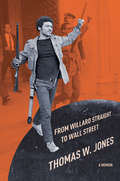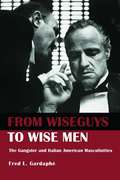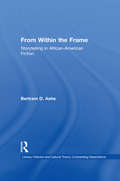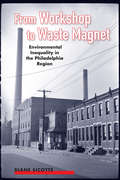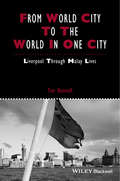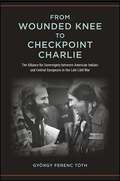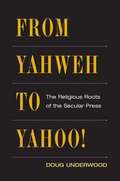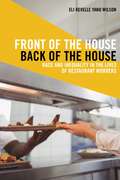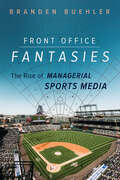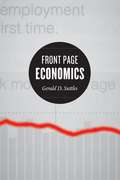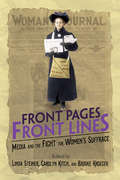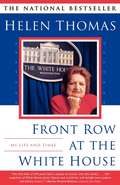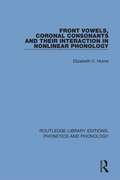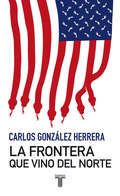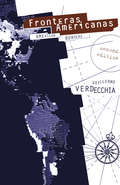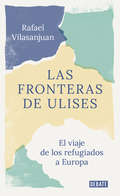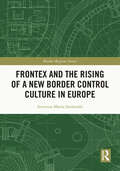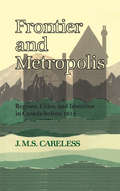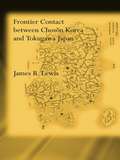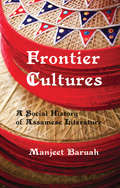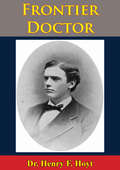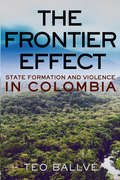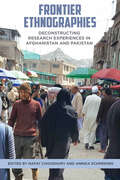- Table View
- List View
From Whispers to Shouts: The Ways We Talk About Cancer
by Elaine SchattnerIt’s hard today to remember how recently cancer was a silent killer, a dreaded disease about which people rarely spoke in public. In hospitals and doctors’ offices, conversations about malignancy were hushed and hope was limited. In this deeply researched book, Elaine Schattner reveals a sea change—from before 1900 to the present day—in how ordinary people talk about cancer.From Whispers to Shouts examines public perception of cancer through stories in newspapers and magazines, social media, and popular culture. It probes the evolving relationship between journalists and medical specialists and illuminates the role of women and charities that distributed medical information. Schattner traces the origins of patient advocacy and activism from the 1920s onward, highlighting how, while doctors have lost control of messages about cancer, survivors have gained visibility and voice.The book’s final section lays out provocative questions facing the cancer community today—including distrust of oncologists, concerns over financial burdens, and disparities in cancer treatments and care. Schattner considers how patients and their loved ones struggle to make decisions amid conflicting information and opinions. She explores the ramifications of so much openness, good and bad, and asks: Has awareness backfired? Instead, Schattner contends, we need greater understanding of cancer’s treatability.
From Willard Straight to Wall Street: A Memoir
by Thomas W. JonesIn stark and compelling prose, Thomas W. Jones tells his story as a campus revolutionary who led an armed revolt at Cornell University in 1969 and then altered his course over the next fifty years to become a powerful leader in the financial industry including high-level positions at John Hancock, TIAA-CREF and Citigroup as Wall Street plunged into its darkest hour. From Willard Straight to Wall Street provides a front row seat to the author's triumphs and struggles as he was twice investigated by the SEC—and emerged unscathed. His searing perspective as an African American navigating a world dominated by whites reveals a father, a husband, a trusted colleague, a Cornellian, and a business leader who confronts life with an unwavering resolve that defies cliché and offers a unique perspective on the issues of race in America today. The book begins on the steps of Willard Straight Hall where Jones and his classmates staged an occupation for two days that demanded a black studies curriculum at Cornell. The Straight Takeover resulted in the resignation of Cornell President James Perkins with whom Jones reconciled years later. Jones witnessed the destruction of the World Trade Center on 9/11 from his office at ground zero and then observed first-hand the wave of scandals that swept the banking industry over the next decade. From Willard Straight to Wall Street reveals one of the most interesting American stories of the last fifty years.
From Wiseguys to Wise Men: The Gangster and Italian American Masculinities
by Fred GardapheThe gangster, in the hands of the Italian American artist, becomes a telling figure in the tale of American race, gender, and ethnicity - a figure that reflects the autobiography of an immigrant group just as it reflects the fantasy of a native population. From Wiseguys to Wise Men studies the figure of the gangster and explores its social function in the construction and projection of masculinity in the United States. By looking at the cultural icon of the gangster through the lens of gender, this book presents new insights into material that has been part of American culture for close to 100 years.
From Within the Frame: Storytelling in African-American Studies (Literary Criticism and Cultural Theory)
by Bertram D. AsheThe book explores the written representation of African-American oral storytelling from Charles Chesnutt, Zora Neale Hurston and Ralph Ellison to James Alan McPherson, Toni Cade Bambara and John Edgar Wideman. At its core, the book compares the relationship of the "frame tale"-an inside-the-text storyteller telling a tale to an inside-the-text listener-with the relationship between the outside-the-text writer and reader. The progression is from Chesnutt's 1899 frame texts, in which the black spoken voice is contained by a white narrator/listener, to Bambara's sixties-era example of a "frameless" spoken voice text, to Wideman's neo-frame text of the late 20th century.
From Workshop to Waste Magnet: Environmental Inequality in the Philadelphia Region
by Diane SicotteLike many industrialized regions, the Philadelphia metro area contains pockets of environmental degradation: neighborhoods littered with abandoned waste sites, polluting factories, and smoke-belching incinerators. However, other neighborhoods within and around the city are relatively pristine. This eye-opening book reveals that such environmental inequalities did not occur by chance, but were instead the result of specific policy decisions that served to exacerbate endemic classism and racism. From Workshop to Waste Magnet presents Philadelphia's environmental history as a bracing case study in mismanagement and injustice. Sociologist Diane Sicotte digs deep into the city's past as a titan of American manufacturing to trace how only a few communities came to host nearly all of the area's polluting and waste disposal land uses. By examining the complex interactions among economic decline, federal regulations, local politics, and shifting ethnic demographics, she not only dissects what went wrong in Philadelphia but also identifies lessons for environmental justice activism today. Sicotte's research tallies both the environmental and social costs of industrial pollution, exposing the devastation that occurs when mass quantities of society's wastes mix with toxic levels of systemic racism and economic inequality. From Workshop to Waste Magnet is a compelling read for anyone concerned with the health of America's cities and the people who live in them.
From World City to the World in One City: Liverpool through Malay Lives (IJURR Studies in Urban and Social Change Book Series)
by Tim BunnellTim Bunnell's book featured in the movie Pulang - the author has recently spoken in several interviews and programmes about how his fascination with the tales of Malay seamen in the UK led to writing this volume: #Showbiz: Sailing into a sea of heartwarming tales | New ...Coming home at last - thesundaily.myhttps://www.youtube.com/watch?v=eiFWYHLz5okFrom World City to the World in One City examines changing geographies of Liverpool through and across the lives of Malay seamen who arrived in the city during its final years as a major imperial port. Draws upon life histories and memories of people who met at the Malay Club in Liverpool until its closure in 2007, to examine changing urban sites and landscapes as well as the city’s historically shifting constitutive connections In considering the historical presence of Malay seamen in Liverpool, draws attention to a group which has previously received only passing mention in historical and geographical studies of both that city, and of multi-ethnic Britain more widely Demonstrates that Liverpool-based Malay men sustained social connections with Southeast Asia long before scholars began to use terms such as ‘globalization’ or ‘transnationalism’ Based on a diverse range of empirical data, including interviews with members of the Malay Club in Liverpool and interviews in Southeast Asia, as well as archival and secondary sources Accessibly-written for non-academic audiences interested in the history and urban social geography of Liverpool
From Wounded Knee to Checkpoint Charlie: The Alliance for Sovereignty between American Indians and Central Europeans in the Late Cold War (SUNY series, Tribal Worlds: Critical Studies in American Indian Nation Building)
by György Ferenc TóthFrom Wounded Knee to Checkpoint Charlie examines the history of the transatlantic alliance between American Indian sovereignty activists and Central European solidarity groups, and their entry into the United Nations in the 1970s and 1980s. In the late Cold War, Native American activists engaged in transnational diplomacy for nation building by putting outside pressure on the US government for a more progressive Indian policy that reached for the full decolonization of Native American communities into independence. By using extensive multinational archival research complemented by interviews, György Ferenc Tóth investigates how older transatlantic images of American Indians influenced the alliance between Native activists and Central European groups, how this coalition developed and functioned, and how the US government and the regimes of the Eastern Bloc responded to this transatlantic alliance. This book not only places the American Indian radical sovereignty movement in an international context, but also recasts it as a transnational struggle, thus connecting domestic US social and political history to the history of Cold War transatlantic relations and global movements.
From Yahweh to Yahoo!: The Religious Roots of the Secular Press
by Doug UnderwoodThis wide-ranging study--hailed by American Journalism as one of the year's best books--provides a fresh and surprising view of the religious impulses at work in the typical newsroom by delving into the largely unexamined parallels between religion and journalism, from the "media" of antiquity to the electronic idolatry of the Internet. Focusing on how the history of religion in the United States has been entwined with the growth of the media, Doug Underwood argues that American journalists are rooted in the nation's moral and religious heritage and operate, in important ways, as personifications of the old religious virtues.
Front of the House, Back of the House: Race and Inequality in the Lives of Restaurant Workers (Latina/o Sociology #10)
by Eli Revelle WilsonHonorable Mention, Mirra Komarovsky Book Award, given by the Eastern Sociological Society2021 Outstanding Academic Title, Choice MagazineHow workers navigate race, gender, and class in the food service industryTwo unequal worlds of work exist within the upscale restaurant scene of Los Angeles. White, college-educated servers operate in the front of the house—also known as the public areas of the restaurant—while Latino immigrants toil in the back of the house and out of customer view.In Front of the House, Back of the House, Eli Revelle Yano Wilson shows us what keeps these workers apart, exploring race, class, and gender inequalities in the food service industry.Drawing on research at three different high-end restaurants in Los Angeles, Wilson highlights why these inequalities persist in the twenty-first century, pointing to discriminatory hiring and supervisory practices that ultimately grant educated whites access to the most desirable positions. Additionally, he shows us how workers navigate these inequalities under the same roof, making sense of their jobs, their identities, and each other in a world that reinforces their separateness. Front of the House, Back of the House takes us behind the scenes of the food service industry, providing a window into the unequal lives of white and Latino restaurant workers.
Front Office Fantasies: The Rise of Managerial Sports Media (Studies in Sports Media)
by Branden BuehlerFront office executives have become high-profile commentators, movie and video game protagonists, and role models for a generation raised in the data-driven, financialized world of contemporary sports. Branden Buehler examines the media transformation of these once obscure management figures into esteemed experts and sporting idols. Moving from Moneyball and Football Manager to coverage of analytics gurus like Daryl Morey, Buehler shows how a fixation on managerial moves has taken hold across the entire sports media landscape. Buehler’s chapter-by-chapter look at specific media forms illustrates different facets of the managerial craze while analyzing the related effects on what fans see, hear, and play. Throughout, Buehler explores the unsettling implications of exalting the management class and its logics, in the process arguing that sports media’s managerial lionization serves as one of the clearest reflections of major material and ideological changes taking place across culture and society. Insightful and timely, Front Office Fantasies reveals how sports media moved the action from the field to the executive suite.
Front Page Economics
by Gerald D. Suttles Mark D. JacobsIn an age when pundits constantly decry overt political bias in the media, we have naturally become skeptical of the news. But the bluntness of such critiques masks the highly sophisticated ways in which the media frame important stories. In Front Page Economics, Gerald Suttles delves deep into the archives to examine coverage of two major economic crashes—in 1929 and 1987—in order to systematically break down the way newspapers normalize crises. Poring over the articles generated by the crashes—as well as the people in them, the writers who wrote them, and the cartoons that ran alongside them—Suttles uncovers dramatic changes between the ways the first and second crashes were reported. In the intervening half-century, an entire new economic language had arisen and the practice of business journalism had been completely altered. Both of these transformations, Suttles demonstrates, allowed journalists to describe the 1987 crash in a vocabulary that was normal and familiar to readers, rendering it routine. A subtle and probing look at how ideologies are packaged and transmitted to the casual newspaper reader, Front Page Economics brims with important insights that shed light on our own economically tumultuous times.
Front Pages, Front Lines: Media and the Fight for Women's Suffrage (History of Communication #148)
by Linda Steiner Carolyn Kitch Brooke KroegerSuffragists recognized that the media played an essential role in the women's suffrage movement and the public's understanding of it. From parades to going to jail for voting, activists played to the mass media of their day. They also created an energetic niche media of suffragist journalism and publications. This collection offers new research on media issues related to the women's suffrage movement. Contributors incorporate media theory, historiography, and innovative approaches to social movements while discussing the vexed relationship between the media and debates over suffrage. Aiming to correct past oversights, the essays explore overlooked topics such as coverage by African American and Mormon-oriented media, media portrayals of black women in the movement, suffragist rhetorical strategies, elites within the movement, suffrage as part of broader campaigns for social transformation, and the influence views of white masculinity had on press coverage. Contributors: Maurine H. Beasley, Sherilyn Cox Bennion, Jinx C. Broussard, Teri Finneman, Kathy Roberts Forde, Linda M. Grasso, Carolyn Kitch, Brooke Kroeger, Linda J. Lumsden, Jane Marcellus, Jane Rhodes, Linda Steiner, and Robin Sundaramoorthy
Front Row at the White House: My Life and Times
by Helen Thomas"I'm still here, still arriving at the White House in the wee hours of the morning, reading the papers and checking the wire, still waiting for the morning briefing, still sitting down to write the first story of the day and still waiting to ask the tough questions." From the woman who has reported on every president from Kennedy to Clinton for United Press International: a unique glimpse into the White House -- and a telling record of the ever-changing relationship between the presidency and the press. From her earliest years, Helen Thomas wanted to be a reporter. Raised in Depression-era Detroit, she worked her way to Washington after college and, unlike other women reporters who gave up their jobs to returning veterans, parlayed her copy-aide job at the Washington Daily News into a twelve-year stint as a radio news writer for UPI, covering such beats as the Department of Justice and other federal agencies. Assigned to the White House press corps in 1961, Thomas was the first woman to close a press conference with "Thank you, Mr. President," and has covered every administration since Kennedy's. Along the way, she was among the pioneers who broke down barriers against women in the national media, becoming the first female president of the White House Correspondents Association, the first female officer of the National Press Club and the first woman member, later president, of the Gridiron Club. In this revealing memoir, which includes hundreds of anecdotes, insights, observations, and personal details, Thomas looks back at a career spent with presidents at home and abroad, on the ground and in the air. She evaluates the enormous changes that Watergate brought, including diminished press access to the Oval Office, and how they have affected every president since Nixon. Providing a unique view of the past four decades of presidential history, Front Row at the White House offers a seasoned study of the relationship between the chief executive officer and the press -- a relationship that is sometimes uneasy, sometimes playful, yet always integral to democracy. "Soon enough there will be another president, another first lady, another press secretary and a whole new administration to discover. I'm looking forward to it -- although I'm sure whoever ends up in the Oval Office in a new century may not be so thrilled about the prospect."
Front Vowels, Coronal Consonants and Their Interaction in Nonlinear Phonology (Routledge Library Editions: Phonetics and Phonology #8)
by Elizabeth V. HumeFirst published in 1994. This study aims to provide evidence for the natural class of sounds comprised of front vowels, front glides and coronal consonants. The author also shows that a revised definition of the articulator feature [coronal] properly characterises this natural class of sounds. The study provides a formal representation of front vowels and coronal consonants and their interaction within a nonlinear model of feature organisation. This title will be of interest to students of language and linguistics.
La frontera que vino del norte
by Carlos González HerreraA partir de un estudio de caso -El Paso, Texas Ciudad Juárez, Chihuahua- Carlos González Herrera hace el recuento de las prácticas socio-culturales de los procesos de construcción y consolidación de los estados nacionales y de sus fronteras comunes, entre 1880 y 1930. La frontera de México con Estados Unidos, tal como hoy la conocemos, es el resultado de una compleja maquinaria cultural y de ingeniería social para que conceptos como soberanía, ciudadanía, Estado-nación, raza, nacional o extranjero se acreditaran como guía de la vida diaria de los habitantes de esta región. El simple trazado de una línea divisoria en 1848, no bastó para que los grupos sociales que la habitaban, aceptaran de manera inmediata una nueva forma de organización. Para Estados Unidos la frontera se convirtió en un proceso de autoafirmación imperial con rasgos políticos, culturales, raciales, médico-científicos, económicos y militares. Mientras que para México, la frontera, continuó siendo una región ajena, atípica; el vacío protector que nos separaba y distanciaba del vecino poderoso. El surgimiento de un discurso -políticamente correcto- del nacionalismo racista de la sociedad sajona para los considerados -extraños- y -razas contaminadas- marcará la fractura insondable: la lucha de clases sociales y de razas de las dos naciones vecinas aún no superada en estos tiempos.
Fronteras Americanas
by Guillermo VerdecchiaFuelled by equal parts outrage, intelligence, and wit, Fronteras Americanas recreates one person's struggle to construct a home between two cultures, while exploding the images and constructs built up around Latinos and Latin America. This one-person play works through bold juxtapositions and satiric reference points: Simón Bolívar and Speedy Gonzales; Columbus and Fodor's travel guides; Ricky Ricardo and the Latin Lover; La Bamba and Placido Domingo; Carlos Fuentes and American drug-war movies. Verdecchia twirls stereotypes and clichés, offers comparative histories, examines myths and mysticism, and provides lessons in language and dancing.However, even as the ungovernable and surrealistic Fecundo Morales Secundo, or "Wideload," edifies us about how sex between a "Latin" and a "Saxon" can be "a mind-expanding and culturally enriching experience," eloquently quoting Octavio Paz and Federico García Lorca in direct response to contemporary struggles and injustices, he also transcends his role of "estereotype," reaching a place beyond maps that are only metaphors where borders are more than divisions between countries and take on the most outlandish properties.In Verdecchia's preface to the new edition, when examining his reasons for bringing forth a "refried" form of Fronteras Americanas in the 21st century, he indicates:There are, after all, people all over the globe living, crossing, resisting, defining, and defending linguistic, cultural, racial, gender, psycho- geographical, cartographic, political and other borders. While the world has changed in many ways since I first wrote and performed it, the processes of migration, displacement, and globalization that informed the play's creation have only accelerated. Some of us may lead more networked lives now, but the Border is alive and well and living all over the globe.Cast of 1 man.
Las fronteras de Ulises: El viaje de los refugiados a Europa
by Rafael VilasanjuánEl relato del viaje de los refugiados: desde la barbarie de la guerra hasta la indiferencia de una sociedad que los rechaza. En 2015, la llegada de más de un millón de refugiados a Europa dejó a la Unión Europea a un paso del abismo, pero la mal llamada «crisis de los refugiados» no la provocaron quienes huían de los conflictos. Equiparando el viaje de los refugiados con el de Ulises, Rafael Vilasanjuan sacude nuestras conciencias y nos confronta con la cruda realidad: incapaces de asumir el fracaso de sus políticas migratorias, las instituciones europeas no solo han dejado de lado sus principios, sino que han convertido a los inmigrantes en enemigos contra los que hay que luchar. Las fronteras de Ulises desvela y deconstruye la falsa idea de «invasión» –impulsada por los movimientos ultranacionalistas pero asimilada por una sociedad mayoritariamente indiferente– para recordarnos que los refugiados no son inmigrantes ni enemigos, sino víctimas de la barbarie en busca de asilo. Negarles ese derecho no es solo éticamente cuestionable, sino ilegal. Como las peripecias de Ulises en La Odisea, este es el relato del viaje de aquellos que huyen de ciudades sitiadas, navegando por las mismas aguas y recalando en las mismas islas en las que hirvió la cultura que acabaría conformando lo que somos ahora. Un viaje, no obstante, donde la épica divina ha sido remplazada por barreras humanas en las que naufragan el legado de la democracia occidental y los derechos humanos.
Frontex and the Rising of a New Border Control Culture in Europe (Border Regions Series)
by Antonia-Maria SarantakiThis book examines the rapidly expanding EU agency’s distinct role in EU border control, showing that Frontex is a prominent border control actor that reshapes the EU borders by promoting a new border control culture. Bringing culture into the analysis of Frontex, this book offers an alternative in-depth understanding of the agency’s function, focusing on the production and diffusion of border control assumptions and practices within a border control community. Based on data drawn from primary research at Frontex and two EU external borders, namely Lampedusa and Evros, this book examines Frontex’s contribution to the emergence of a new border control culture in Europe, replacing the pre-existing Schengen culture. Compared with the existing literature on Frontex, this novel account takes into consideration the evolving nature of borders and border control, discussing three contemporary challenges for the established border control regime: Brexit, the COVID-19 pandemic, and hard security preoccupations, such as the fall-out from the Russian invasion in Ukraine and the weaponisation of migration at the Greek-Turkish land border. Frontex and the Rising of a New Border Control Culture in Europe will appeal to scholars and students of border management, EU studies, migration, geography, international relations, and security, along with policymakers and practitioners with an interest in EU border control and Frontex.
Frontier and Metropolis: Regions, Cities, and Identities in Canada before 1914
by J.M.S. CarelessThe regional character of Canada and the crucial role of metropolitan development in its history have been recurring themes in the work of J.M.S. Careless. In these essays he returns to those themes, discussing how national and regional identity in Canada show vital links with metropolitan-hinterland relationship across time and space.The first essay presents an overall appraisal of the historic connections between metropolitan centres and frontiers or regions in Canada. These connections might be manifested in economic structures, political fabrics, or social networks, and also in modes of opinion and popular images and traditions. The second part of the book inquires into some major conceptual treatments given to frontier and metropolis in history. The third seeks to evaluate the impact of metropolitanism on distinctive features of identity that are revealed in Canadian historical experience. A fourth essays rounds out the volume by discussing the influence of external metropolanism in Canada.Careless endows his subject with the combined fornce of his own continuing research, his sensitivity to the new historical scholarship, and the lively and penetrating mind that have made him one of Canada's leading historians for more than thirty years.
Frontier Contact Between Choson Korea and Tokugawa Japan
by James B. LewisEast Asia from 1400 to 1850 was a vibrant web of connections, and the southern coast of the Korean peninsula participated in a maritime world that stretched to Southeast Asia and beyond. Within this world were Japanese pirates, traders, and fishermen. They brought things to the Korean peninsula and they took things away. The economic and demographic structures of Kyongsang Province had deep and wide connections with these Japanese traders. Social and political clashes revolving around the Japan House in Pusan reveal Korean mentalities towards the Japanese connection. This study seeks to define 'Korea' by examining its frontier with Japan. The guiding problems are the relations between structures and agents and the self-definitions reached by pre-modern Koreans in their interaction with the Japanese. Case studies range from demography to taxation to trade to politics to prostitution. The study draws on a wide base of primary sources for Korea and Japan and introduces the problems that animate modern scholarship in both countries. It offers a model approach for Korea's northern frontier with China and shows that the peninsula was and is a complex brocade of differing regions. The book will be of interest to anyone concerned with pre-1900 East Asia, Korea in particular, and especially Korea's relations with the outside world. Anyone interested in early-modern Japan and its external relations will also find it essential reading.
Frontier Cultures: A Social History of Assamese Literature
by Manjeet BaruahThe study of Assamese literature has so far been in terms of the history of the Assamese language. This book is a history of the narratives written in Assamese language and its relation to the process of region formation. The literature dealt with ranges from pre-colonial chronicles, ballads and drama to modern genres of fiction and critical writing in Assamese language. Taking the Brahmaputra valley and Assamese literature as case studies, the author attempts to link literature, its nature and use, to processes of region formation, arguing that such a study needs to take the context of historical geography into consideration. The book views region formation in north-east India as a dialectical process, that is, the dialectic between the shared and the distinct in inter-group and community relations. It borrows an anthropological approach to study written narratives and cultures so as to locate such narratives in specific processes of region formation.
A Frontier Doctor
by Henry F. HoytThis is the autobiography of the famous Henry F. Hoyt, a medical doctor and notable adventurer of the American West. His career started as a physician in the Goldrush town Deadwood, before moving west into the Texas Panhandle. He was by turns a Doctor, a Vigilante and a Cowboy, and he recounts stories of Charlie Siringo, John Chisum, Cole Younger, Billy The Kid, Jesse James, and many other figures of the Wild West. During the Spanish-American War he served as Chief Surgeon, was wounded and decorated in the Philippines, his life was one adventure after another. Illustrated with photographs.
The Frontier Effect: State Formation and Violence in Colombia (Cornell Series on Land: New Perspectives on Territory, Development, and Environment)
by Teo RogersIn The Frontier Effect, Teo Ballvé challenges the notion that in Urabá, Colombia, the cause of the region's violent history and unruly contemporary condition is the absence of the state. Although he takes this locally oft-repeated claim seriously, he demonstrates that Urabá is more than a case of Hobbesian political disorder.Through his insightful exploration of war, paramilitary organizations, grassroots support and resistance, and drug-related violence, Ballvé argues that Urabá, rather than existing in statelessness, has actually been an intense and persistent site of state-building projects. Indeed, these projects have thrust together an unlikely gathering of guerilla groups, drug-trafficking paramilitaries, military strategists, technocratic planners, local politicians, and development experts each seeking to give concrete coherence to the inherently unwieldy abstraction of "the state" in a space in which it supposedly does not exist. By untangling this odd mix, Ballvé reveals how Colombia's violent conflicts have produced surprisingly coherent and resilient, if not at all benevolent, regimes of rule.
Frontier Encounters
by Franck Billé Grégory Delaplace & Caroline HumphreyChina and Russia are rising economic and political powers that share thousands of miles of border. Yet, despite their proximity, their practical, local interactions with each other — and with their third neighbour Mongolia — are rarely discussed. The three countries share a boundary, but their traditions, languages and worldviews are remarkably different. <p><p> Frontier Encounters presents a wide range of views on how the borders between these unique countries are enacted, produced, and crossed. It sheds light on global uncertainties: China’s search for energy resources and the employment of its huge population, Russia’s fear of Chinese migration, and the precarious economic independence of Mongolia as its neighbours negotiate to extract its plentiful resources. <p> Bringing together anthropologists, sociologists and economists, this timely collection of essays offers new perspectives on an area that is currently of enormous economic, strategic and geo-political relevance.
Frontier Ethnographies: Deconstructing Research Experiences in Afghanistan and Pakistan
by Nafay Choudhury Annika SchmedingEthnography destabilizes the notion of the frontier as merely a geographic space and conveys its limitations—that lead researchers to reflect on their methodological approaches. Frontier Ethnographies explores the ethnographic edges of contemporary anthropological inquiry in Afghanistan and Pakistan by assembling voices of emerging scholars who have conducted field research within the region in the past two decades. Through examining moments of insecurity, vulnerability, doubt, fear, failure, and daydreaming, researchers reflect on their own experiences of field research and how—faced with frontiers—they have been forced to reimagine or reconstruct their understanding of the social world.

